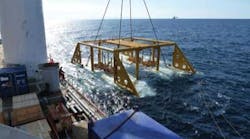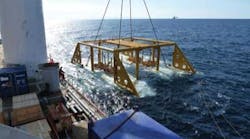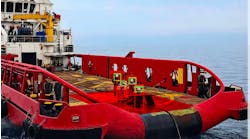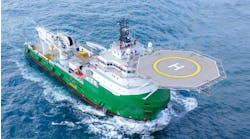Automatic mud tank cleaning system cuts costs, risks
Martin Hunter
Felipe S. Liporace
Stephen C. Hamlett
M-I SWACO
An automatic cleaning system is reducing the risks and downtime of manual mud tank cleaning on rigs and supply vessels. Mud tank cleaning is mandatory to avoid cross-contamination when displacing one fluid with another.
The fully automated, closed-loop technology most recently was field tested in Brazil to clean the tanks of two supply vessels storing both synthetic-base and oil-base drilling fluids. The results were compared against the slower, labor-intensive manual cleaning process, where 100% confined space entry poses significant HSE risks.
During the exercise at a supply base in Vila Velha, Espírito Santo, regular cleaning time was reduced more than 30% on average and confined entry time was cut more than 35%. Moreover, by using the automated process, the operator reduced the total waste generated at the source by more than 33%, with most of the cleaning water recycled for re-use, a result that is impossible with traditional cleaning methods.
The build-up of solids in static mud or when preparing to displace one type of drilling fluid either with another mud or a completion brine requires the tanks of both the rigs and supply vessels to be cleaned thoroughly. This is to eliminate any chance of residual from the original fluid contaminating the new fluid and causing myriad performance problems.
Labor-intensive process
Historically, the cleaning of mud tanks and pits typically involved laborers equipped with hoses, pressure washers, shovels, and squeegees – a process some liken to an archaic bucket brigade. Not only was manual cleaning slow and labor-intensive, it also posed a host of HSE risks, primarily linked to exposure to harmful vapors and the potential for injuries to the crew working in such cramped quarters. The economic benefits of the automatic cleaning technology are particularly evident in the deepwater, where the time required to manually clean storage tanks before receiving the new fluid often results in expensive downtime.
As the activity levels and costs of the offshore operations began to rise exponentially (particularly in deepwater), the industry sought a cost-effective and safer alternative to manual tank cleaning. A team of specialists first examined how other industries clean storage tanks. This examination was followed by definining and analyzing the demands of the oilfield, focusing primarily on reducing downtime while rigs and boats are being cleaned; minimizing generated waste; and limiting both the time and number of personnel subjected to confined space entry. The investigation led to the engineering of a prototype system that has since been modified and upgraded.
The specific benefits derived with the automatic system depend on the targeted application, not the least of which is the internal design of the tank being cleaned. The configuration of the system and the cleaning pattern depend on whether the targeted storage tank is round or square with a flat or sloped bottom, and the number of internal obstructions such as pipework and agitators. In addition, the speed of the cleaning process also hinges on the specific mud type, the cleaning frequency, and the efficiency of the tank agitation system.
How it works
Portable automatic tank cleaning (ATC) units are equipped with pumps, tanks, cones and programmable logic controllers (PLCs) that supply wash solution to the tank cleaning machines (TCMs), which actually are specialized nozzles. Usually, multiple cleaning machines are placed permanently inside the tanks with the precise number and placement dependent on the cleaning pattern and the geometry of the particular tank.
When cleaning is to take place, a portable ATC unit is brought onboard where the cleaning machines are connected to the ATC skid containing pumps that send a mixture of surfactant and water to the individual cleaning machines. The automated technology uses specialized chemicals that prevent the formation of emulsions and provide easy separation of the wash water for recycling.
Lab tests dictate the chemical composition of the cleaning fluids, based on the drilling fluid to be removed, with the primary consideration being environmental acceptability, including the capacity of the fluid to biodegrade.
During the operation, powerful water jets follow a specially programmed cleaning pattern to clean every surface inside the tank. The programmed pattern can be regulated according to the tank design and cleaning needs.
Either a portable slop pump or the boat or rig tank pumps transfer the slop back to a wash-water recycling unit inside the ATC unit, where the liquid phase is separated from the solids. Chemical reaction and the unique configuration of the tank in the recycling unit combine to separate the slop.
The solids settle rapidly in the recycling tank and are pumped to a skip. At that point, the wash water is passed through a bank of microclones to remove any remaining solids that likewise are sent to the skip, while any water in the skip is recovered and sent back to the recycling system. Once this is accomplished, the wash water is in a condition to be reused for cleaning. This is a continuous process and multiple tanks can be cleaned with the same conditioned wash water.
When cleaning tanks containing synthetic-base drilling fluid, the same wash water can be used repeatedly and only requires fresh water additions to replace any wash water lost as moisture on solids. With tanks containing water-based mud, the wash water is deposited into a slop tank to allow for settling. The clean water can be pumped back to the ATC unit as needed to reduce the amount of fresh water used.
Liquid is directed back to the cleaning machines to be reused as cleaning fluid until it becomes too contaminated with fine solids. At the end of the operation, the cleaning fluid and solid waste, predominantly comprising barite weight material, are safely removed from the installation or reused in a new drilling fluid. The process is simplified in areas such as the Gulf of Mexico where treated cuttings from synthetic-base and water-base drilling fluids can be discharged overboard.
Comparative benefits
The automated cleaning system has cleaned both rigs and supply vessels worldwide, including in the North Sea, West Africa, Southeast Asia, Brazil, and the Gulf of Mexico, where it was used to clean 10 tanks on a semisubmersible rig under a tight weather window. Prior to the introduction of the automated unit, the rig pits were cleaned using a vacuum system, pressure washers, shovels, and squeegees – a process that required two personnel working an average of six to eight hours per tank, nearly all of which was confined entry. That process generated from 60 to 100 bbl of slop per tank. The automatic system cleaned six of the 10 tanks within the tight weather window, saving the operator an estimated three days downtime.
Throughout the development of the automated system, the economic, HSE, and operational benefits have been quantified in a number of comparative analyses against the conventional manual cleaning process.
Early in its development, the automated system and its manual counterpart were analyzed head-to-head on a North Sea supply vessel containing two identical tanks. The key performance indicators of the comparative analysis were the number of skips required to haul off the generated wastes, the cleaning time, and the time required for confined space entry.
During the initial test, the automatic system required only two personnel, compared to five for the manual process, to clean the entire tank in one hour with no confined entry required. Conversely, the tank cleaned with the manual process had not been completed after five hours and once finished had required a cumulative 20 man-hours during and after the process. In a follow-up test, one of the key performance indicators focused on the waste generated by comparing the number of skips required. The waste produced by the manual procedure required 21 skips to shore, while the automatic cleaning system required 12, for a 43% reduction. The comparison was even more dramatic when the investigation examined the performance of cleaning machines installed inside the tanks permanently, rather than on a per-job basis.
Without the time required for the pre-job installation, one boat was cleaned completely in an average of 17 hours with a seven-man crew, with confined entry reduced to less than 1%. Moreover, over a seven-month period, the automated process with the cleaning machines installed permanently saved a total of 70 boat-days. By comparison, when a North Sea-class supply vessel was cleaned entirely with the manual process, it took upwards of four days for one boat, requiring 60 to 100 workers within the various tanks.
Brazil evaluation
Operators in Brazil have long sought an alternative that would not only hasten the turnaround time for cleaning deepwater supply vessels, but also reduce the total wastes produced during the shore-based cleaning operation. The fully automated system was evaluated earlier this year in Vila Velha, Espírito Santo, Brazil. There, over a nearly one-month period, six cleaning operations cleaned a total of 27 tanks on two supply vessels holding both synthetic and water-base drilling fluid. Again, the key performance indicators were cleaning time, confined space entry, and the volume of waste generated. The results were compared with the manual process with vacuums and pressure washers, and entailed an extremely difficult cleaning scenario.
For one thing, the tanks had been used to carry 16.3 lb/gal (1.9 sg) top-hole PAD mud comprising an extremely large volume of barite that had settled in the bottom of the tanks.
In addition, the agitator motors in the tanks reportedly had failed, meaning the mud was not stirred continuously, further aggravating the difficulties. Since the mud had been static in the tanks for 10 to 14 days, the settled barite on eight of the tanks had become very compacted and hard. Consequently, the condition of the settled barite in the eight tanks required confined space entry to break-up the settled barite and bucket a significant portion of the solids out of the tank, which ultimately represented 30% of the total cleaning operation. Despite the barite settlement, total confined space entry time was reduced from the 100% required of a total manual process to 35%, which mostly involved breaking up the barite on the affected tanks and polishing the blind spots at the end of the operation.
The analysis further compared the turnaround time of regular manual and the automated process in tanks where barite had and had not settled. In tanks without any barite settling, regular cleaning averaged six hours, while the automatic system averaged two hours per tank. However, in the tanks with severe barite settlement, per-tank cleaning time increased to more than nine hours.
Regardless, an average for all operations showed the automatic system reducing total cleaning time to just over four hours per tank with average confined entry dropping to 34%. The average of 15 cu m (530 cu ft) of waste generated with the regular cleaning process was reduced to an average of 5.1 cu m (180 cu ft) or 33% for the total operations; and 10 cu m (353 cu ft) for the tanks with barite settlement.
A post-operation analysis suggested that the cleaning time could be reduced to less than two hours, or more than 30% of that required for manual cleaning, on tanks with agitation sufficient to prevent barite from settling.
Offshore Articles Archives
View Oil and Gas Articles on PennEnergy.com





